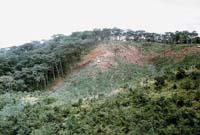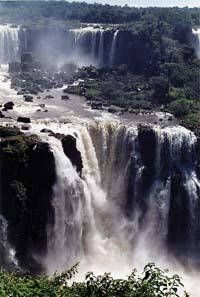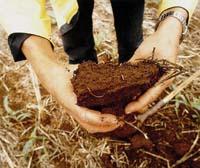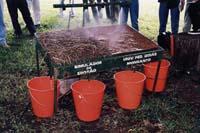To the desertification of Stop
2006/06/01 Galarraga Aiestaran, Ana - Elhuyar Zientzia Iturria: Elhuyar aldizkaria

According to the United Nations, desertification has become a very serious global problem. Except in Antarctica, desertification processes are occurring on all continents. Even in humid climate zones, the earth is losing fertility. In most cases this loss is due to human activity.
Until recently the exhaustion of the land only seemed disturbing in arid areas. In these areas the soil is especially vulnerable, it is easily lost and its recovery is difficult. In addition, it is related to water scarcity, and if all this adds to the population growth, the result is poverty.
Aware of this, international and local institutions have launched several projects to prevent desertification. They are mainly based on the change in soil use, which has caused the loss and/or sterilization of the soil in many places, due to improper use or overexploitation.
For example, the logging of forests by fires, the possession of more livestock than desired in the same place, the installation of orchards irrigated in areas not suitable for this, etc., have caused the inertization of the soil in wide areas. The most significant examples are in Africa, some aspects of Asia and Australia.
Now, with another type of tillage and land use, these damages are expected to be repaired or at least not to extend the problem to areas where the soil is still productive. Joint management of land and water as non-renewable resources is essential.

The United Nations highlighted the importance of these measures in the section dedicated to desertification, within the work Ecosystems and human well-being published last year. Along with this, they commented that to stop desertification it is really useful to maintain the green cover of the land, that is, vegetation.
They also explained that the harmonization of agriculture and livestock and their joint development benefit the land in dry and semi-arid sub-humid areas. In fact, animal deyections fertilize the soil and, on the other hand, favor the alternation of traditional crops with livestock forages.
In addition, they gave other solutions. It was recommended to start other productions with benefits that do not exhaust the land so much.
For example, the location in dry areas has meant for some small producers to obtain benefits in tourism, greenhouse agriculture or fish farms - plastic covers to prevent evaporation of the water. Local conditions, such as heat, sunshine hours, lack of competition, have been used for their benefit.
Of course, the possibility of living outside drylands or in cities also contributes to preventing desertification, and the United Nations has warned on several occasions in the report that preventing is cheaper and easier than recovering land that is beginning to desert.

Drinking from the source of tradition
The United Nations Educational, Scientific and Cultural Organization (UNESCO) has an interesting project to combat desertification. That is, develop strategies to combat desertification from popular wisdom.
Thus, the United Nations Convention to Combat Desertification and Land Degradation (UNCCD, 1998) contains 78 traditional techniques. Some of them are related to water use, others with increased soil fertility, vegetation conservation, forestry, the fight against wind or water erosion, etc. Finally, others are related to social organization, architecture and energy.
UNESCO recognizes the importance and value of these techniques. In his opinion, many times current technologies work in a differentiated and specialized way and he hopes that the results are immediate. They use external resources and are expensive, in addition, they make local people available to external providers.
On the contrary, thanks to popular wisdom, vulnerable places have been exploited for centuries without being exhausted. Popular wisdom uses traditional techniques that are not simple methods or procedures, but have ethical and aesthetic values. An example of this is the water collection systems of many villages in Africa, which besides having technical structures, are beautiful.
There are more examples in which art, nature, techniques and people converge; for example, in the hairstyle of Saharawi women you can see the images generated by the water distribution system.

We must also take into account the spiritual or sacred aspect, as is the case of some African forests that have survived because they are sacred to their inhabitants. Something similar can be said about the mountainous summits of Euskal Herria: in some cases, if there are still no antennas or other facilities, it is because many people have opposed it, because it has somehow sacred places.
Therefore, UNESCO is making an effort to collect and analyze traditional techniques to learn from them and use them in the fight against future desertification.
From past to future
However, UNESCO has also analyzed criticism of traditional techniques. On the one hand, they are accused of being very local and limited. And in reality, because each traditional technique provides a solution to a specific situation. This does not mean that it cannot be used anywhere else, but that there will be places with similar situations where techniques from elsewhere may be used.
Others consider that compared to current technologies, traditional technologies are neither competitive nor effective. However, it has often been shown that the most suitable solution for the place where it is used is the one that has been traditionally used.

For example, in the Moroccan region of Ziz, until the Ar-Rachidiya reservoir was built, its inhabitants carried out nomadic agriculture to overcome water scarcity. But since the swamp ensured that water was enough, they abandoned that life and made a city. Now they have great difficulties to quench the thirst of the citizens and even more to devote themselves to agriculture. Something similar has happened in the Béchar region of Algiers. There, since the construction of the reservoir, agricultural land has become deserts.
Other criticisms of traditional techniques are their exclusive use in the Southern Hemisphere, and their resistance to technology is what underpins traditional habits. On the contrary, UNESCO is clear that neither is true.
However, although UN projects against desertification have been designed by technicians who know the latest technologies, they have often been based on traditional techniques. A close example? In the restoration of the dunes of Laida have been made, so far, plantations of species that support the sand to stabilize the dunes. Like in the sand deserts.






